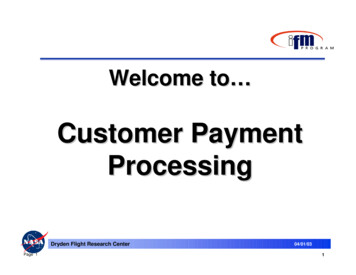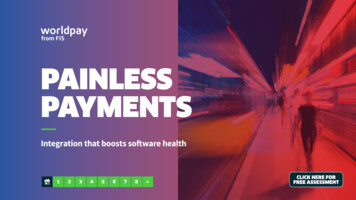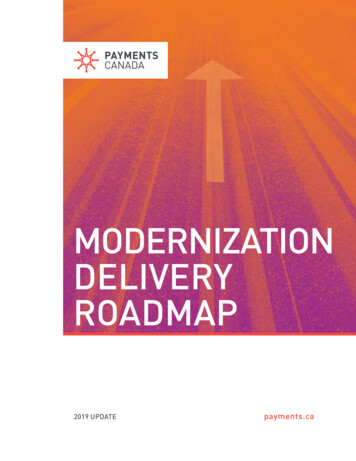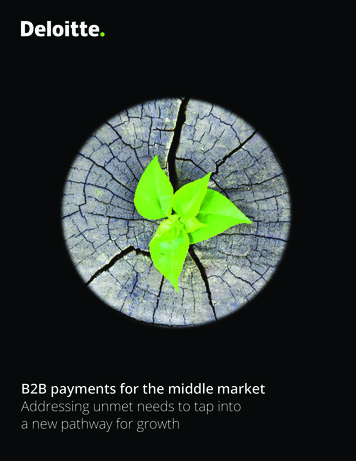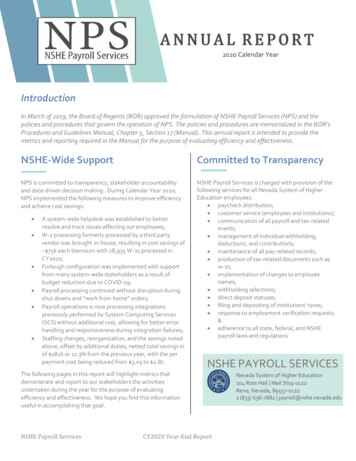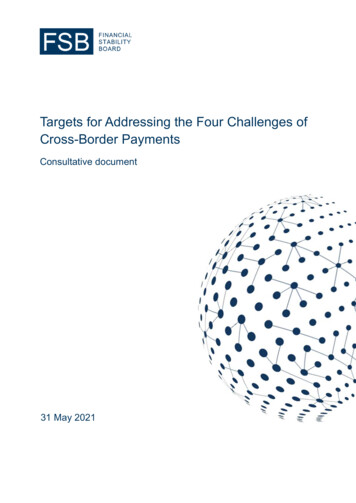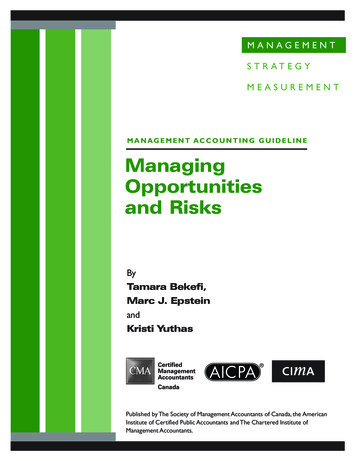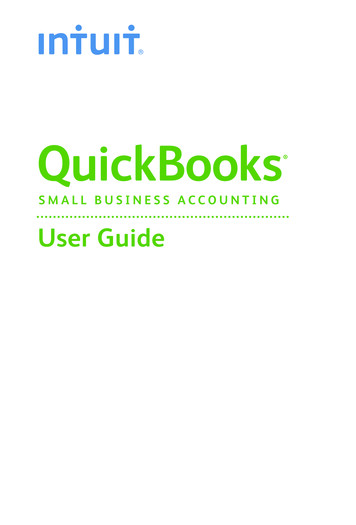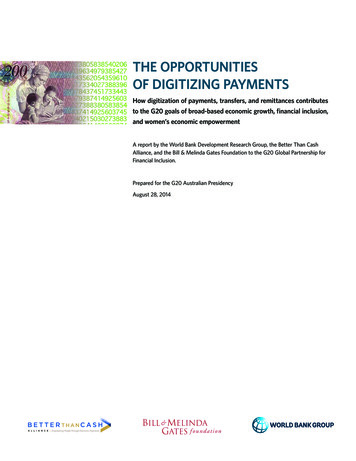
Transcription
THE OPPORTUNITIESOF DIGITIZING PAYMENTSHow digitization of payments, transfers, and remittances contributesto the G20 goals of broad-based economic growth, financial inclusion,and women’s economic empowermentA report by the World Bank Development Research Group, the Better Than CashAlliance, and the Bill & Melinda Gates Foundation to the G20 Global Partnership forFinancial Inclusion.Prepared for the G20 Australian PresidencyAugust 28, 2014
2014 International Bank for Reconstructionand Development/The World Bank1818 H Street NW Washington, DC 20433Telephone: 202-473-1000Internet: www.worldbank.orgThis work is a product of the staff of the WorldBank with external contributions. The findings,interpretations, and conclusions expressed inthis work do not necessarily reflect the views ofthe World Bank, its board of executive directors,or the governments they represent.The World Bank does not guarantee the accuracy of the data included in this work. Theboundaries, colors, denominations, and otherinformation shown on any map in this workdo not imply any judgment on the part of theWorld Bank concerning the legal status of anyterritory or the endorsement or acceptance ofsuch boundaries.Rights and PermissionsThe material in this work is subject to copyright. Because the World Bank encouragesdissemination of its knowledge, this work maybe reproduced, in whole or in part, for noncommercial purposes as long as full attributionto this work is given.Any queries on rights and licenses, includingsubsidiary rights, should be addressed to the:Office of the PublisherThe World Bank1818 H Street NW Washington, DC 20433, USfax: 202-522-2422email: pubrights@worldbank.orgACKNOWLEDGEMENTSThis report was prepared by Leora Klapperand Dorothe Singer of the Finance and PrivateSector Development Team of the DevelopmentResearch Group of the World Bank.Inputs and guidance were received from SheilaMiller of the Bill & Melinda Gates Foundation,Ruth Goodwin-Groen of the Better Than CashAlliance (hosted by UNCDF), Mary Ellen Iskenderian of Women’s World Banking, WorldBank Group experts, as well as the membersand implementing partners of the G20 GlobalPartnership for Financial Inclusion (GPFI),including the Alliance for Financial Inclusion (AFI), the Consultative Group to Assistthe Poor (CGAP), the International Fund forAgricultural Development (IFAD), and theOrganization for Economic Co-operation andDevelopment (OECD).
THE OPPORTUNITIESOF DIGITIZING PAYMENTSKEY FINDINGS AND RECOMMENDATIONSFOR GOVERNMENTSiiINTRODUCTION1I. THE BENEFITS OF DIGITAL PAYMENTS3II. THE CHALLENGES OF DIGITAL PAYMENTS10III. PROMOTING DIGITIZATION13CONCLUSION17FOCUS TOPICSTHE INCREASING IMPORTANCE OF REMITTANCES23EXPANDING ACCESS TO DIGITAL PAYMENTS IN RURAL AREAS 24FOUR PRINCIPLES FOR PRIVATE SECTOR ENGAGEMENT25
The Bill & Melinda Gates Foundation and the Better Than Cash AllianceiiTHE OPPORTUNITIESOF DIGITIZING PAYMENTSKEY FINDINGS AND RECOMMENDATIONS FOR GOVERNMENTSDigitizing payments and remittances is vital to achieving G20 goals. The G20’s focus onfinancial inclusion directly contributes to its core goal of achieving strong,sustainable, and balanced growth. Studies show that broader access to andparticipation in the financial system can reduce income inequality, boost jobcreation, accelerate consumption, increase investments in human capital, anddirectly help poor people manage risk and absorb financial shocks.Strong action on financial inclusion by G20 countries and other key stakeholders willcontribute significantly to key G20 policy objectives by: Spurring broader and stronger economic growth, by deepening financialintermediation and increasing efficiency of and access to payment, savings,insurance, and credit services. Increasing life opportunities and economic benefits for migrant anddiaspora communities, by enabling a sharp reduction of costs and increasedtransparency of remittances. Increasing women’s economic participation, by facilitating greater controlover finances, household incomes, and budget decisions.Rapid development and extension of digital platforms and digital payments can provide the speed, security, transparency, and cost efficiency needed to increase financialinclusion at the scale required to achieve G20 goals.In 2010, the G20 endorsed Principles for Innovative Financial Inclusion to provideguidance for policy and regulatory approaches (G20, 2010). This paper builds on thatguidance, synthesizing the evidence that the widespread adoption of digital paymentsin all their forms, including international and domestic remittances, can be instrumentalin reaching the goals of the G20: Digitizing helps overcome the costs and physical barriers that have besetotherwise valuable financial inclusion efforts. Digital platforms offer the opportunity to rapidly scale up access tofinancial services using mobile phones, retail point of sales, and otherbroadly available access points, when supported by an appropriate financialconsumer protection framework. Digital payments can promote women’s economic empowerment byfacilitating greater account ownership and asset accumulation andincreasing women’s economic participation. Digital payments, particularlyby governments and employers, enable the confidentiality and conveniencewomen require in financial services. Payments provided via an accountcan provide the on-ramp to financial inclusion and in many cases the firstaccount that a woman has in her own name and under her control. Openingan account can be an important first step for introduction to the formaleconomy for an entrepreneur and can lead to formalization of her smallbusiness.
iiiTHE OPPORTUNITIESOF DIGITIZING PAYMENTSKEY FINDINGS AND RECOMMENDATIONS FOR GOVERNMENTSWhile the opportunities abound, so do the challenges. There are real and complexbarriers for governments to address through vision and leadership. Governments mustaddress regulatory concerns, work with the private sector to develop infrastructure thatcan reach rural areas, and ensure interoperability and competition among providersand financial capability among their citizens. There is also a real and growing momentum on the part of governments, the private sector, multilateral development banks,and development partners in this direction, but with 2.5 billion people still outside theformal financial system, there is an urgent need for these issues to be more prominentin the agenda of governments.In the short term, we call on governments, when they meet in November 2014 at theG20 Brisbane Summit, to discuss how they can embrace a broad-based digital financialsystem as a path to growth, greater participation of women in the economy, and greateraccess to payments, including remittances.We encourage Turkey to carry forward the good work that Australia has begun within the Global Partnership on Financial Inclusion (GPFI) on these issues, particularly with their work on remittances,markets, and payments. By the end of the 2015 G20 Summit hosted by Turkey,we call on governments to make progress and report back on the following steps:1. Digitize payments and receipts,including social transfers.Digitizing has the potential to dramatically reduce costs, increase efficiency and transparency, help build the infrastructure, and broaden familiarity with digital payments.When governments shift their social, salary, and procurement payments and taxationand licensing receipts to electronic form, it creates a foundation upon which the privatesector and person-to-person payments, such as international and domestic remittances,can build.2. Engage activelyon the regulatory agenda.Some regulators are still hesitant to embrace the digital financial revolution that is emerging, and have reasonable concerns that need to be specifically addressed. Governmentsneed to encourage regulators to enable digital financial services in order to achieve G20goals. Specifically, regulation should: Foster competition by enabling a broad range of providers to introduce newvectors of financial services. Ensure that consumer protection and risk-based prudential and integrityrequirements are met. Address the cost of entry and encourage business model innovation fore-money issuers, retail agents, and account opening processes. Encourage new business models to address the critical concerns thatconfront regulators, including anti-money laundering and counter financingof terrorism (AML/CFT). The Financial Action Task Force (FATF) hasissued guidelines that address these concerns, and many countries aresuccessfully implementing the guidelines. Brazil’s approach, with mobilepayments regulations that allow nonbanks to offer payments and savingsand to directly access the central bank’s clearing and settlement system,is paving the way for a number of new commercial partnerships to go tomarket. Mexico’s approach of tiered know-your-customer regulations isproviding more flexibility for private-sector providers who participate in thedistribution of government payments, and enabling the development of newproduct design.The Bill & Melinda Gates Foundationand the Better Than Cash Alliance
ivTHE OPPORTUNITIESOF DIGITIZING PAYMENTSKEY FINDINGS AND RECOMMENDATIONS FOR GOVERNMENTS3. Convene public and privatesectors to create a basicpayment infrastructure to enablecompeting product development.Public and private sectors can converge around a payments platform, and enable innovation and competition in additional financial services. A safe, reliable, secure, andaffordable platform, open and shared among market participants, will act as the catalystof financial inclusion and will foster adoption of basic financial services at a large scale.4. Create an environmentthat fosters private sectorinnovation.The private sector is a critical partner in this endeavor, and there is a real opportunityto catalyze private-sector growth. Yet governments need to offer a clear vision andtangible incentives in order to ensure that the private sector is an effective, competitive,transparent, and efficient partner. Part of this requires that a level playing field be set up,whereby governments do not create disproportionate hurdles for a broad and growingrange of providers to participate in the global financial system. Limiting innovation andcompetition will ultimately lead to noncompetitive solutions in the market and reducethe availability of reliable, safe, and secure financial systems. Empowering a diverse rangeof private-sector providers will increase competition, reduce costs, empower consumers,increase the scale needed for sustainability, and drive financial inclusion.5. Guide digital financial serviceproviders to educate consumersand small businesses about theiroptions to increase confidence,competence, and adoption.Recipients should understand, for example, how the cash- transfer program works, theimportance of PIN numbers, what to do if something goes wrong, and how they cansave some or all of the payment rather than withdrawing all of it upon receipt. Withoutthis, there is a risk that recipients could lose trust in the system, and financial inclusionobjectives would not be achieved. Evidence indicates that consumers and small businesses rapidly learn how to be competent and comfortable in using these systems whenthey are appropriately designed, convenient, and efficient.6. Recognize that remittanceproviders offer a digital entrypoint to formal financial servicesfor senders and receivers.This means family members who are sending international and domestic remittancescan send more money home. Instead of remittances being cashed out, remittancessent to a bank account, e-wallet, or smart card, for example, can go into accounts thatsupport safe saving and also increase transparency and traceability.7. Look to multilateral developmentbanks and comparable agenciesas sources of comparativeexpertise in this emerging field.Governments may need technical assistance and resources as they undertake thisagenda. It is particularly important that development banks pay focused attention tothe role of women in the economy and develop special advice on the economic resourcepresented by women.There is now a great opportunity for the G20 collectively to develop robust, specificinitiatives under each of these action headings. Only governments have the authority to be prime movers on much of this agenda, especially with respect to regulatoryreform, driving electronic payments via payroll and social benefit disbursements, butin partnership with the private sector.The Bill & Melinda Gates Foundationand the Better Than Cash Alliance
1THE OPPORTUNITIESOF DIGITIZING PAYMENTSINTRODUCTIONFinancial inclusion is broadly defined as both access to and usage of appropriate, affordable, and accessible financial services. Comparative global data finds that the useof a deposit account at a bank or other formally regulated financial institution varieswidely across regions, economies, and individual characteristics. Worldwide, 50 percentof adults report having an individual or joint account at a formal financial institution,according to data from the Global Findex database (Demirgüç-Kunt and Klapper, 2012).But current statistics on the high rate of financial exclusion, particularly in developingcountries and among women, illustrate key challenges for policymakers to address: Globally, more than 2.5 billion adults do not have a formal account. Only about one out of every five adults living on less than 2 (U.S.) per dayhas a formal account—that means nearly 80 percent of poor adults areexcluded from the formal sector. While accounts are nearly universal in high-income economies, with 89percent of adults reporting that they have an account at a formal financialinstitution, less than half that number of adults in developing economies isbanked: only 41 percent.Adults with an account at a formalfinancial institution (%) For women in developing countries, the situation is worse: Only 37 percenthave formal accounts, compared to 46 percent of men.0–1516–3031–5051–8081 NO DATADemirgüç-Kunt, A. and L. Klapper, 2013.IBRD 39220 MARCH 2012This map was produced by the Map Design Unit of theWorld Bank. The boundaries, colors, denominations, andany other information shown on this map do not imply, onthe part of the World Bank Group, any judgment on thelegal status of any territory, or any endorsement oracceptance of such boundaries.Without access to the formal financial system, women, poor people, small businesses,and otherwise excluded people must rely on their own (extremely limited) informaland semiformal savings and borrowing to finance educational and entrepreneurialinvestments, thus making it harder to alleviate income inequality and spur broad-basedeconomic growth. However, those who are excluded from the formal financial systemare likely to be recipients of payments1—not just wages and government-sponsoredsocial transfers, but also, increasingly, remittances from family members who have lefthome in search of economic opportunity either elsewhere in the country or abroad.
2THE OPPORTUNITIESOF DIGITIZING PAYMENTSINTRODUCTIONIndeed, Global Findex data also highlights the important role that deposit accounts canplay in the financial lives of adults in low-income countries when they do indeed haveaccounts, especially with regard to the receipt of formal payments, such as wages,government transfers, or remittances. While only 24 percent of adults in low-incomecountries have an account, less than 40 percent of account holders in those countriesuse their accounts for such payments.Meanwhile, innovations in the payment sector have led to the emergence of electronicpayment service providers able to facilitate formal payments even in the absence ofaccounts, such as over-the-counter (OTC) payments, mobile money payments, andpayment cards.Improving access to financial services has progressed steadily on the G20 agendasince leaders first committed to the effort at the Pittsburgh Summit in 2009 and thenendorsed the nine Principles for Innovative Financial Inclusion at the Toronto Summitin 2010. At the Seoul Summit, also in 2010, leaders established the Global Partnershipfor Financial Inclusion (GPFI) to carry forward work on financial inclusion, includingimplementation of the G20 Financial Inclusion Action Plan. 2In this paper, we review the body of research that has emerged on digital payments—defined as payment alternatives to cash— including domestic and internationalremittances, and then suggest steps that all stakeholders—governments, the privatesector, and the international development community—can take to hasten the spreadof digital payments.In the first section, we review the benefits of digital payments for governments, recipients, and providers. Not only do digital remittances lower costs for the senders andrecipients of payments, but they also increase access to the banking system, the privacyand transparency that they afford, and security throughout the system. This has theadded advantage of giving a significant boost to women’s economic empowerment.In the next section, we explore the challenges that face countries around the worldas they look to increase the use of digital remittances. For example, to put in place arobust system of digital payments requires significant physical infrastructure— not justmobile telecommunications, but also accessible cash- out points. Also, the literatureshows that one cannot ignore the human element: New users of digital payments needto be educated about how to use them, the other banking options they open up, andhow the overall system works, as well as why it should be trusted.The third section offers suggestions for governments and the private sector on howthey can facilitate the spread of digital payments within their countries and globally.Governments can lead by example, both by using digital payments themselves and bycreating a regulatory environment conducive to digital innovation. The private sectorcan continue to innovate, invest in infrastructure, leverage public-private partnerships,and create and maintain convenient, reliable, and secure networks. And the internationaldevelopment community can act as both a resource of expertise and a facilitator ofdigital payment expansion, where appropriate.Ultimately, overcoming the challenges of moving toward digitized payments will helpaccomplish goals at the heart of the G20 countries’ efforts to encourage inclusiveeconomic growth around the world.
IZINGDIGITIZINGPAYMENTSKEYTHEFINDINGSAND RECOMMENDATIONSFOR GOVERNMENTSI.BENEFITSOF DIGITALPAYMENTSA Gallup, Inc. survey of 11 countries in Sub-Saharan Africa found that more than 80percent of adults make bill payments or remittances with cash (Kendall et al., 2014).Given the lack of digital-payment penetration, governments, consumers, and financialproviders in Sub-Saharan Africa are still bearing the high cost of cash payments—costsassociated with manual acceptance, record keeping, counting, storage, security, andtransportation.USE OF ACCOUNTSTO RECEIVE PAYMENTSAdults using an account in the pastyear to receive payments (%)MIDDLE EAST & NORTH AFRICAFROM WORK6OR SELLING GOODSFROM THEGOVERNMENT3SOUTH ASIAYet, advancements in technology and electronic-platform- based business models haveallowed many governments to increase the efficiency and scope of their electronicpayments infrastructure. For example, a 2011 study of 62 developing and high-incomecountries (representing approximately 81 percent of the total world population) foundthat over 77 percent of countries have an e-payments system in place for social security contributions by citizens, and around 84 percent of countries researched haveelectronic and/or automated systems for vehicle-related payments such as fines andtolls (EIU, 2012).Digital payments have many benefits, to both senders and receivers. Moving from cashbased to digital payments
G20 Brisbane Summit, to discuss how they can embrace a broad-based digital financial system as a path to growth, greater participation of women in the economy, and greater . markets, and payments. By the end of the 2015 G20 Summit hoste

